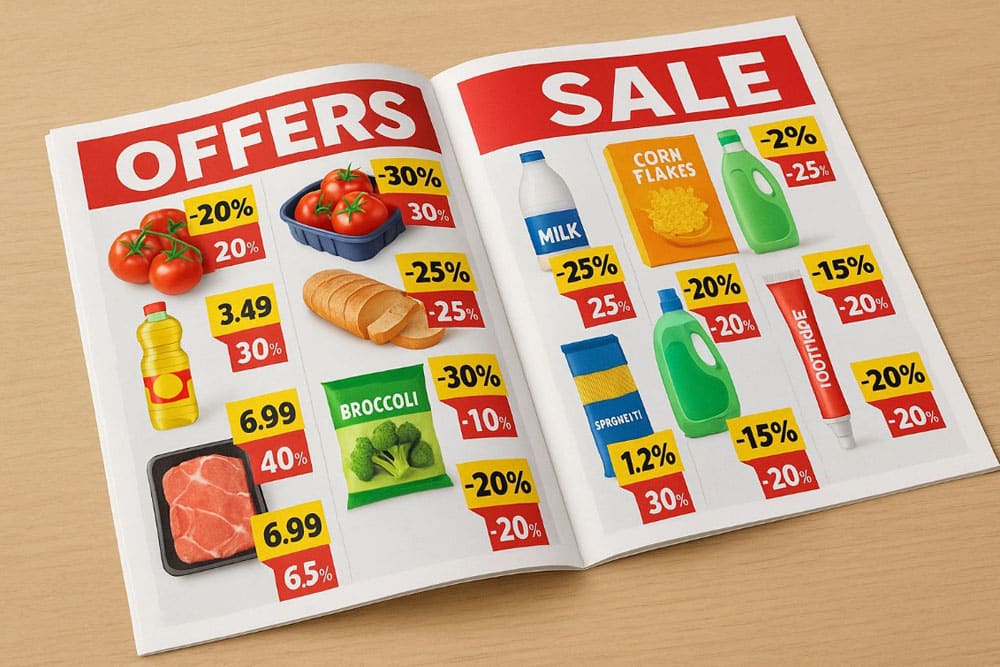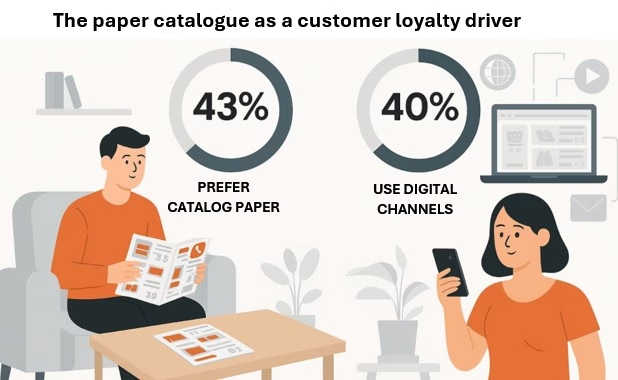Retailers have eliminated the paper catalog (and paper in general) as a channel for communicating with customers. Yet, the latest market studies show that paper remains popular with consumers.

The paper catalogue still holds its place in retail. This is the conclusion of a market research study we recently delivered to two leading European retailers. In the digital age, one might have thought this medium was doomed to disappear. In fact, that’s not the case. It is still favored by consumers and remains a strategic tool for informing them, particularly in local stores. The catalogue remains indispensable in many households for planning purchases and spotting promotions. In this article, I share concrete figures and my reflections on the topic.
Contact IntoTheMinds market research agency for your marketing studies
Paper Catalogue: Statistics for the French Market
- -10%: the decline in communication spending on print media between 2023 and 2024
- 78% of French consumers regularly visit local stores
- 44% of French consumers consult a retail paper catalogue at least once a week
- 43% of consumers prefer the paper catalogue over the digital format
- 32% of customers primarily get information from catalogues received in their mailboxes
- 30% of consumers still rely on word-of-mouth for their purchasing decisions
- 58% of French customers value the paper catalogue for its ease of access
- 53% of customers use it to plan their grocery shopping
Between 2023 and 2024, retailers’ spending on print communication dropped by 10%.
Why Is Paper Disappearing in Retail?
It’s important to distinguish between the catalogue and the flyer. Ultimately, both have been impacted by a series of negative factors:
- Shift to digital during the COVID-19 pandemic
- Implementation of restrictive laws on print advertising due to environmental policies
- Cost-saving efforts by retailers
- Lack of traceability on the impact of paper on in-store purchases
Let’s take a concrete example from France. In September 2022, the government launched a test in 14 pilot regions where the distribution of paper flyers was banned unless individuals displayed a “Oui Pub” sticker on their mailbox. This was a nudging strategy, shifting from “opt-out” to “opt-in.” The test ended in May 2025. The results were mixed:
- 10,000 job losses in the print advertising sector
- No positive environmental impact observed (source: Ademe)
- Negative effects on toy retailers and local stores
Contact us for your retail studies
The Paper Catalogue as a Customer Loyalty Tool
Those who follow my blog know that I am an advocate for customer loyalty. The figures show that, from this perspective, the paper catalogue still has much to offer retailers.
Market research shows that the paper catalogue continues to play a central role in building customer relationships. As mentioned in the introduction, its physical presence and visibility in households allow customers to recall the brand and integrate it into the customer journey. In particular, 46% of consumers expect to find exclusive benefits related to loyalty programs in it.
The challenge with the paper catalogue lies in its profitability being measured only by traceable purchases, leading to its declining appeal compared to digital channels. However, its relevance should be viewed in a broader context, where its effects are less easily measurable.
Paper Catalogue and Digital Channels: Aiming for Complementarity
The perspective expressed in the previous paragraph leads me to address the role of digital. Let me be clear: I don’t pit digital against paper in retail. The customer relationship is omnichannel, and both formats have their place. What’s striking is that 40% of consumers use the digital channels provided by retailers, yet the paper catalogue remains preferred by 43% of consumers. This raises questions: is this a “nostalgia” effect among consumers, or is there a genuine need?
The market research we conducted for two retail giants in another European country where catalogues are still in use confirmed the latter hypothesis. The paper catalogue was used by over 40% of these retailers’ customers. Age-group analysis showed, as expected, that older individuals were more inclined to use paper catalogues, but the difference was only 5 percentage points compared to the 18-35 age group.
I like to think that paper catalogues and apps/websites are complementary tools for retailers. I remain hopeful that retailers will adopt a more “holistic” view of the customer journey and rediscover the value of paper.
The Paper Catalogue for Local Stores
The results presented in the previous paragraphs might suggest that the paper catalogue is exclusive to large retailers. However, local stores can also benefit from it. The experiment conducted in France between 2022 and 2025 officially showed that the removal of paper negatively affected local stores, as it was a cost-effective way for them to attract new customers.
By definition, local stores have a smaller catchment area than supermarkets. Local retailers know their customers’ needs better, can more easily offer personalized services, and thus need a channel to communicate. In fact, market research shows that 88% of French consumers visit local stores due to the human connection. Extending this customer relationship is therefore essential.
Conclusion
Rather than concluding solely on the merits of paper media in retail, I’d like to broaden the discussion to focus on the human aspect. Retail is certainly a transactional act, but it is also a human relationship. There is no customer loyalty in retail without a human component. The paper medium can be an extension of this relationship.
Advertising media, whether digital or physical, should be considered a step in the customer journey. I believe that, when viewed within the customer journey, the paper catalogue, in particular, has a rightful place. It allows the brand to maintain and materialize its presence. The misfortune of paper is that none of this is easily measurable.
Even as large retailers gradually phase out the paper channel, I remain convinced that it still has a future as a marketing tool.









![Illustration of our post "Remarketing: definition, advantages, and strategies [Guide 2023]"](https://5cc2b83c.delivery.rocketcdn.me/app/uploads/remarketing-120x90.jpg)

